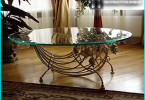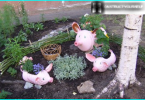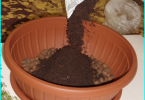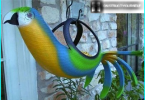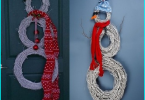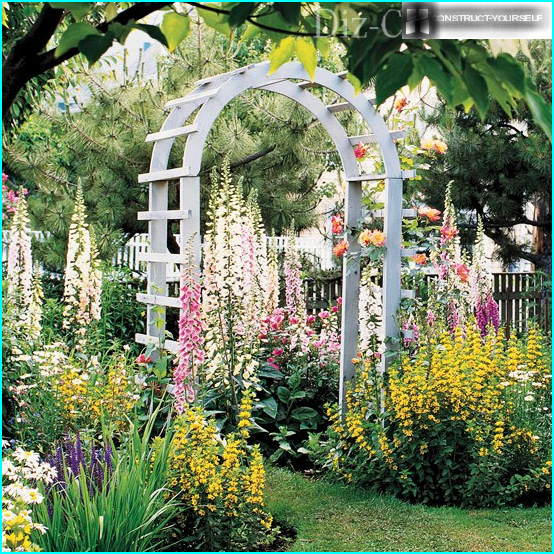
The technology and materials of the facades of houses think still on the design stage. The exterior of the building must fit in with the landscape to be neat and beautiful. Besides the decorative function, the façade performs a purely practical task – insulates, zvukousilitel the building, protects the supporting structures against the effects of moisture, wind, steam, temperature extremes. The facade cladding needs to be hygienic, resistant to the ravages of fungi, mold, which often cause the appearance of cracks in the walls. How to choose material for the facade of a private house? What are the challenges?
The contents
Stroyrynok offers many different types of materials. Choosing how to decorate the facade of the house, the buyers often stop at these:
- decorative plaster;
- clinker bricks and tiles;
- granite;
- siding;
- the sandwich panel;
- stone – natural and artificial;
- facade cassettes.
Each of these materials has its own advantages and disadvantages. Prices vary significantly. When designing the house in advance to determine the budget for the purchase of finishing materials. Their advantages, disadvantages and specific properties will be discussed below.
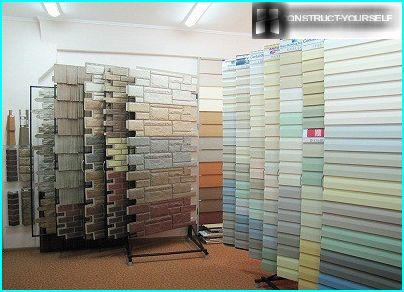
Variety of materials for facades is huge, you can always choose a suitable option for any type of house
Option #1 — facade, decorative plaster
Plastering the front of the house is the most «ancient» the type of finish. In recent decades a unique plastering materials, designed for finishing of different kinds of materials.
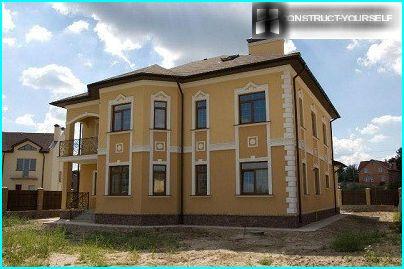
There are many types of smooth and textured plaster for facades. The technology of drawing on the walls also differ markedly. This nuance should be taken into account and carefully study the instructions for any kinds of material
Due to the wide range and reasonable cost of plaster for facades has not lost its popularity. Its benefits:
- Aesthetics. A huge variety of colors, many textures. If desired, each owner can create a unique exterior of the house.
- Water resistance. All kinds of facade plasters protect the building from damp. Insulation materials do not get wet, allowing less dissolved, and the years do not lose their properties.
- Frost resistance. If the plastering of the building was not admitted gross technological error, the material does not burst in cold weather, tolerates temperature extremes.
- Ease of application. Plastering does not need costly special equipment, just normal tools, which are in every house. Having the right skills, a home owner can handle yourself.
Next, we consider the subspecies of the plaster and examine how they differ from each other.
Mineral plaster: cheap and beautiful
This is the most common finishing material. Advantages – extensive color palette and low price. The mineral-based plaster different biological stability, are not conducive to multiplication of microorganisms. Finish is resistant to moisture, direct sunlight.
Scope of application mineral plaster is practically unlimited. It does not burn, it is used for finishing of buildings with combustible insulation. The disadvantages include the low elasticity. When the building shrinks, the surface finish cracks.
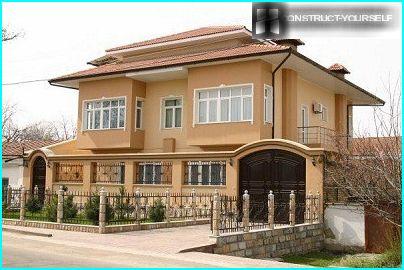
Mineral decorative plaster has virtually no restrictions on compatibility with the building and insulating materials. It is applied on concrete, drywall, Board materials, plywood. Mineral plaster is suitable for decoration of caps
Acrylic finishing materials
Unlike mineral or acrylic plaster is much more flexible. It does not crack from shrinkage home. It is elastic and durable material that retains the original look for several years.
Acrylic stucco resistant to frost and moisture, but the surface is trimmed in this material, relatively quickly get dirty. Buyers plaster based on acrylic is more expensive than mineral. The material is flammable, it should not be used for facades, insulated with mineral wool.
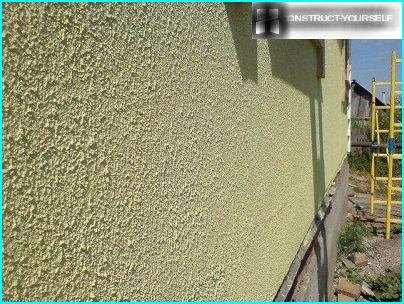
Before beginning work with acrylic plaster it is necessary to prepare walls. The surface should be smooth, with no visible flaws and cracks. Then the coating will adhere well to the wall and will remain durable for many years
Features silicate plaster
Silicate plaster is one of the most durable materials. The finish can last two to three decades, without losing the appearance and performance properties for a long time. She almost dirty. If dust and dirt still cling to the surface easily washed off in the rain. This plaster is not burst the shrinkage of the house and moisture proof.
Technology silicate plaster you need to apply on the surface that requires the employee to maintain a high level of professionalism and usually means additional costs for the services of a team of builders. Another item of expenditure – the purchase of a special primer. Colors do not vary.
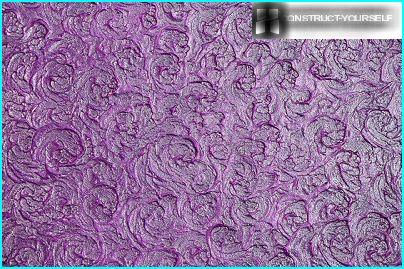
In the manufacture of silicate plaster apply potash glass, which provides material of high performance. This kind of plaster is not used for internal finishes due to the presence in the composition of substances that affect human health. But for fronts it fits perfectly
Silicone plaster: in step with the times
Silicone (siloxane) plaster is the ideal material for facade finishing. He has no shortcomings, except high prices. If the budget allows, it makes sense to stay on this type of finish. Silicone plaster is distinguished by high wear resistance, able to last for several decades and is suitable for facades with any insulating materials.
The material is durable, never needs cleaning, self-cleaning under influence of precipitation, wind. If the house is located next to a highway or in a densely populated area, faces it is better to decorate it with silicone plaster, because it will remain clean under all circumstances. Additional «bonus» for the owner of the building – easy application of the material on the surface. Read more about this in the video:
Option #2 — clinker bricks and tiles
Clinker brick similar to conventional construction. There are over hundreds of types of brick with different texture and a rich color palette. Clinker brick is a natural material made of clay with addition of natural dyes. Due to the natural raw materials and characteristics of manufacturing, the color of brick can vary, so if you have to buy the material from different batches, it is desirable to mix, to avoid the apparent mismatch of colors.
There are three main types of material:
- a brick facade;
- sidewalk;
- tiles.
The front surface you can choose for every taste: glossy, matte, patterned or glazed. Clinker brick is durable, does not absorb water (water absorption rate of 3%). Exterior finish is easy to clean if dirty. You can use any household chemicals, because the material is resistant to chemically aggressive environments. Clinker bricks and tiles tolerate high and low temperatures, are durable. The only drawback is the high cost and complex installation (you will need skilled builders).
About the features of the fabrication material to learn from the video:
Option #3 — durable and aesthetic porcelain
Granite is one of the best decorative materials for facades of private houses. On the surface it is impossible to apply the pictures, but this does not affect aesthetics. The range is huge, there are hundreds of shades and lots of texture. Looks especially impressive rainbow granite. There is material which imitates natural wood or stone. If desired, the owner can create an exclusive residence with granite.
The physical properties of the material:
- Strength and durability. Like other building materials from clay, porcelain tiles are extremely durable, as resistant to abrasion and mechanical damage.
- Moisture resistance. Granite does not absorb water, whereby a high resistance to frost. On its surface no cracks.
- Resistance to temperatures. Granite is perfectly resistant to any temperature, does not react to the extremes. The material does not burn and does not change the technical-operational characteristics even when heated up strongly.
- Permanent color. The material does not change color. Because of the increased durability, the finish of the facade will be almost eternal.
- Specific installation. This property should be attributed to the weaknesses that are the flip side of the advantages of low hygroscopicity. Granite mounted on metal frame or on a special glue. If you put in the grout, it can fall off in the cold.
Manufacturers produce porcelain tiles with different surfaces:
- Matt. The material is not subjected to further processing, so the surface has a natural appearance, and the finish has the best performance properties.
- Polished. It is called satin. Feature – noble surface with a waxy Shine. The effect is achieved by the addition of mineral salts. The material is more matte, and the properties do not differ.
- Glazed. Beautiful glazed surface resembles a ceramic tile, but porcelain is much stronger.
- Polished. The surface is polished with special abrasives. The material is a rich sparkling color, suitable for interior and exterior use.
- Propolisovaya. The front side of the material originally looks thanks to a spectacular combination of shiny and matte sections.
- Structured. This kind of facade of the private house is characterized by a richness of textures. The material can be patterned, embossed, rough, simulating the texture of wood or stone.
- Mosaic. Luxury mosaic panels are able to completely transform the building. Porcelain stoneware mosaic difficult to style, but the result is worth the effort. The home owner can buy mosaic mass production, and order the exclusive version.
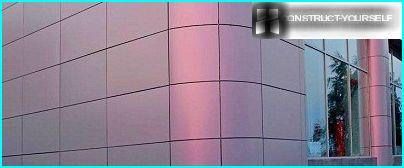
Granite is suitable for cladding new and restoration of old buildings. Updated the old building will look gorgeous within a few decades
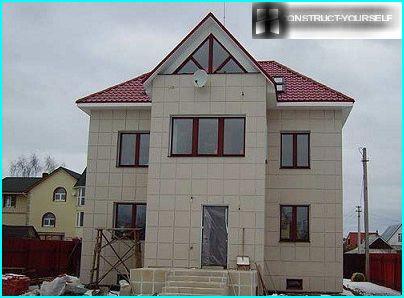
Cladding choose a granite with tile thickness from 12 mm, ideally 14-16 mm. the Optimum sizes, easy to use: 300х600, 600×600 mm and 600х900
Option #4 — decorative siding
Siding is a decorative panel. This is one of the most beautiful types of cladding. The material is easy to install, protects the supporting structures against external negative influences. There are the following types of siding:
- Vinyl. This PVC panels, appearance of which may mimic natural wood, stone or brick. There are many types of vinyl siding, so the choice of decoration is almost unlimited. PVC panels are lightweight, resistant to temperature, mechanical stress and is cheap. The only caveat: when mounting take into account the coefficient of linear expansion so that the finish is not lost appearance with temperature changes.
- Wooden. Finishing panels made from dried and/or treated with antiseptics of wood. The material holds heat well, looks nice, is environmentally friendly, however, compared to other types of siding roads, short-lived and require special care.
- Metal. It is made from steel or aluminum. With the obvious advantages of metals (durability, resistance to temperature, hygiene, etc.) there are obvious disadvantages. When damaged the top layer metal panels starts the corrosion process.
- Cement. This heavy siding that increases the weight of the whole structure. There is a need to strengthen the Foundation. But he replaces the stone, very reliable and not affected by external factors.
- Ground. As a ground use brick or siding PVC panels. This is a thick finishing material, designed for high operating loads.
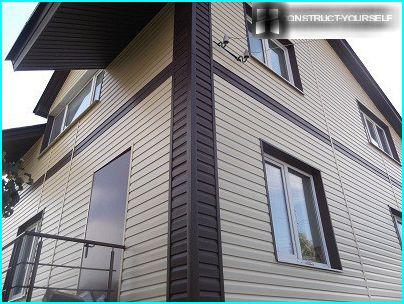
When choosing siding, pay attention to color uniformity, the thickness of the panel, the size gvozdevyh holes (should be the same). Ask about the warranty obligations of the manufacturer
Option #5 — sandwich panel
The word «sandwich» the title panels very correctly describes the structure of the material. It consists of two dense layers, between which is located insulation. It is successfully used when decorating new houses and renovation of old. The material is very beautiful, various, light, moistureproof, fireproof, durable.
If one of the panels is damaged, it can be replaced without dismantling the whole facade claddings. Sandwich panels are not the most expensive finishes, but with the right combination of materials can reduce the overall cost of the construction of the house.
Detailed information about the types, benefits, disadvantages of sandwich panels are presented on video:
Option #6 — natural and artificial stone
Choosing for facade cladding stone, the owner of the house certainly agrees to high costs. However, it is a profitable investment, because within several decades it will be possible to forget about the repair or replacement of finishes. It will remain durable, reliable, beautiful and resistant to any effects.
Artificial stone is cheaper and gives more scope for design imagination than natural, and their properties are a little different. It is the perfect material. The facade you can decorate the panels with any stone: granite, marble, basalt, quartzite, limestone, Sandstone, slate or limestone.
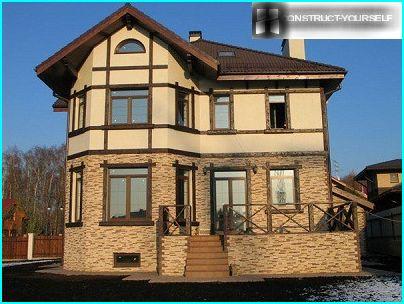
Facing natural stone – very expensive. The stone can be combined with other, more «democratic» materials and thus to obtain a luxurious appearance of the house
Option #7 — tech cluster facade
Metallocycle widely used for mounting of ventilated facades. Cassettes are mounted on special rivets or screws hidden or open way. The choice of colors, textures and sizes is huge, which greatly expands design capabilities in the design of the house.
The material is reliable, durable, resistant to all destructive factors, eco – friendly and fire safe. He has virtually no weaknesses, except high cost. This is a great option for the restoration of facades of old buildings and finish of buildings.
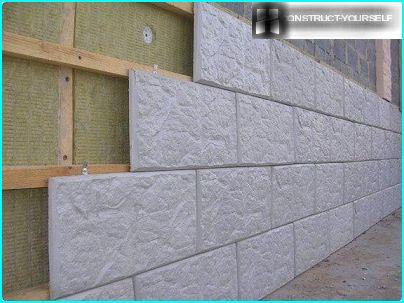
For fixing of ventilated façade requires a special substructure. Sometimes used a system in which the cassettes are secured on a special «sled»
What to choose?
View videos of the architect:
In most cases, homeowners choose the cheapest materials, because the budget is not dimensionless. But the saying about the miser pays twice, do not forget. Choosing your future front, pay attention to whether the material combined with the insulation and the material of the bearing walls. Consider durability, degree of thermal insulation, corrosion resistance.
If you wish, you can always find a suitable option of beautiful, practical and economical plating. If there is any doubt, it is better to consult with a specialist.
According to the website Question-Repair.ru.

